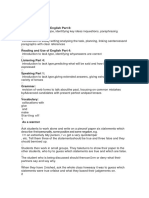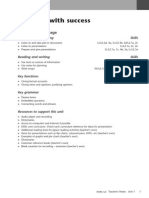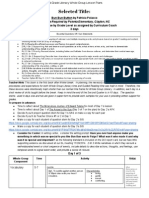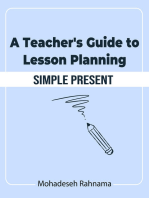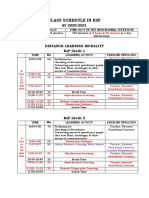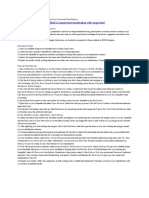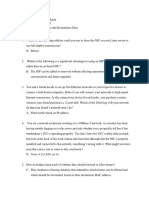Success in Lesson Planning
Uploaded by
clau_roli4400Success in Lesson Planning
Uploaded by
clau_roli4400Success in Lesson Planning
For truly professional teachers, lesson planning is not optional, it is essential preparation for
teaching. It is a matter of deciding exactly what you are going to teach, and how. Unless you
establish your objectives and activities in this way, you may find yourself just going
mechanically through the coursebook, or trying to improvise whole lessons. Such approaches
usually produce poor results, although some improvisation and flexibility is good, even
essential, in teaching. Learners can easily notice the difference between teachers who plan and
those who do not. And if their teacher does not make an effort, why should they? To begin
your lesson plan, decide where the lesson fits into your week's work plan or teaching cycle.
Then establish specific objectives for the lesson. These will largely be determined by the
phase in the teaching cycle. Here are some examples of lesson objectives:
To present and achieve controlled production of a new grammatical-functional item.
To achieve guided communicative use of a new item.
To achieve the communicative use of a mixed range of language in writing.
To promote the learners' confidence in the conversational use of English.
To develop comprehension of public announcements.
The activities and materials should be appropriate for your objectives, and also for your
specific group of learners. When deciding on appropriate activities and materials, take into
account the learners' age, interests, and abilities. Calculate the approximate time for each
activity so that you do not end up doing only half of what you planned, or having no plan for
the last quarter of the lesson. And remember that there needs to be a variety of activity and
interaction, for example, between pairwork, groupwork, and individual work. Here is a typical
lesson plan:
Group: 3B
Room: 7
Unit: 8
Time: 8.00-9.00 p.m.
Date: 8th April
Objectives / teaching points:Fluency / consolidation practice of Present Perfect
(presentation/accuracy practice last class) combined with Simple Past.
Development of conversation and listening skills.
Specific objectives/activities Materials / aids Procedures / interactions Time
1 To warm up LL, establish topic, Photos of TQ-LA Have you ever _____ed? 5
get conversation practice: snorkelling, Where/When? mins
Discussion of holiday activities water-skiing,
horse riding, etc. > PRS
2 To establish holiday discussion Cassette 23.7 Task 1: Who wants to go to 10
situation, give listening practice, Table on board Scotland? Who wants to go to the mins
lead into main activity: Listening for lists of Costa Brava? Why?
to friends discussing their holiday activities
plans Task 2: List things to do in Scotland
and the Costa Brava
3 To get LL to use Pres. Perf. + Poster with T and L model conversation similar 15
Past in free conversation: GPS of choice of to cassette > GPS of three, mins
three agree on holiday holiday resorts, instructions to note reasons for
destination, give reasons things to do in decision: Yuri has been to… and he
each doesn't want to go again. Ana has
seen a bullfight and didn't like it.
Bogdan has never…
4 To check use of Pres. Perf. and Same poster Representative of each GP reports to 15
Past: class: We decided to go to ______ mins
GP reports because… ; We decided not to go to
______ because…
5 To clarify use of Pres. Perf., Handout: IND fill-in > Check in PRS > Check 10
wind down: dialogue fill-in on board mins
Dialogue fill-in
Homework: Holiday composition
Key: T = teacher; TQ = teacher questions; L(L) = learner(s); LA = learner answers; PRS = pairs;
GP(S) = group(s); IND = individual; > leads to/followed by
The main elements and considerations in the above plan are:
Clear stages: warm-up (1); lead-in (2); main activity (3); follow-up (4); and wind-
down (5) - and smooth transitions between them.
A unifying theme, running through the conversation, listening, and writing activities.
Appropriate relationships between objectives, activities, materials, and procedures.
Attention to both the communicative use of English and formal correctness in the
language, i.e. fluency and accuracy.
Consideration of the learners' interests and the learning conditions, as well as the
grammatical-functional items in the syllabus.
The stages and transitions give a comfortable flow to the lesson. Each stage requires different
behaviour from the teacher, a different level of effort from the learners, and changes in pace.
A spare activity - for example, a game or quiz - could have been included at the end in case
the lesson went faster than anticipated. The learners are provided with enough input - photos,
a model conversation on cassette, and a poster - to get them going, but they are also given the
opportunity to use their personal experience in realistic tasks. The interest of the topic and
tasks, the changes of activity and interaction, and the relatively relaxed pace, should help the
learners through this late class - 8.00 to 9.00 in the evening. Obviously, lesson plans need to
vary according to the age and level of the learners, the objectives, the time of day, and even
the time of year. Young learners need more changes of activity and more physical activity.
They have much shorter attention spans than older learners, and can get very restless. Older
learners at higher levels can sometimes work enthusiastically at the same task for quite long
periods of time. Lessons at the end of a long morning, the end of a long day, or just before a
holiday period, need to be lighter than other lessons. During or after a lesson you can make a
few notes on the plan, and it will then act as the starting point for the following lesson plan. A
book, folder, or file of such plans can be a permanent record of the progress achieved with a
particular group, and may serve as the basis for even better plans next time you teach the
course.
You might also like
- 8th Grade Daily Language Practice (Pdfdrive)100% (6)8th Grade Daily Language Practice (Pdfdrive)114 pages
- Observation Report # 3 - Teaching ListeningNo ratings yetObservation Report # 3 - Teaching Listening4 pages
- CEP Lesson Plan Template: Review or Preview (If Applicable)No ratings yetCEP Lesson Plan Template: Review or Preview (If Applicable)7 pages
- Study With Success: Curriculum CoverageNo ratings yetStudy With Success: Curriculum Coverage18 pages
- Lớp 9A3_Anh_tiết 21 Unit 3- Lesson 6 - Skills -2No ratings yetLớp 9A3_Anh_tiết 21 Unit 3- Lesson 6 - Skills -25 pages
- CELTA Written Assignment Four - Lessons From The ClassroomNo ratings yetCELTA Written Assignment Four - Lessons From The Classroom3 pages
- CEP Lesson Plan: Review or Preview (If Applicable)No ratings yetCEP Lesson Plan: Review or Preview (If Applicable)4 pages
- CEP Lesson Plan Template: Review or Preview (If Applicable) Put Agenda On BoardNo ratings yetCEP Lesson Plan Template: Review or Preview (If Applicable) Put Agenda On Board4 pages
- Langston - Bun Bun Button - 2nd Grade 2015No ratings yetLangston - Bun Bun Button - 2nd Grade 20158 pages
- Bruce Tung 11-21-14 Cep Toefl Prep LP - Week 9No ratings yetBruce Tung 11-21-14 Cep Toefl Prep LP - Week 93 pages
- Teaching English as a Second or Foreign Language Collection: Task-Based Learning, Warm-Ups, and Technology Games, Activities, & ResourcesFrom EverandTeaching English as a Second or Foreign Language Collection: Task-Based Learning, Warm-Ups, and Technology Games, Activities, & ResourcesNo ratings yet
- You Can Teach This Class - 194 Inspirational Teaching ActivitiesFrom EverandYou Can Teach This Class - 194 Inspirational Teaching ActivitiesNo ratings yet
- Precalculus mathematics for calculus student solutions manual 6th edition Edition Bulman-Fleming all chapter instant download100% (1)Precalculus mathematics for calculus student solutions manual 6th edition Edition Bulman-Fleming all chapter instant download67 pages
- Two-Column Template For Conference Proceedings Based On IEEE Format (Title)No ratings yetTwo-Column Template For Conference Proceedings Based On IEEE Format (Title)3 pages
- Acc Algebra I Geometry A Comprehensive Course OverviewNo ratings yetAcc Algebra I Geometry A Comprehensive Course Overview36 pages
- Class Schedule in Esp: Regular Time Slot Time Slot in The New Normal SituationNo ratings yetClass Schedule in Esp: Regular Time Slot Time Slot in The New Normal Situation5 pages
- Religion Compass Volume 1 Issue 6 2007 (Doi 10.1111/j.1749-8171.2007.00043.x) Ann Jeffers - Magic and Divination in Ancient IsraelNo ratings yetReligion Compass Volume 1 Issue 6 2007 (Doi 10.1111/j.1749-8171.2007.00043.x) Ann Jeffers - Magic and Divination in Ancient Israel15 pages
- Dual Diploma Student Quickstart 2023-2024finalNo ratings yetDual Diploma Student Quickstart 2023-2024final16 pages
- Islamic Studies & Ethics-Outline SS-1007.docx SpringNo ratings yetIslamic Studies & Ethics-Outline SS-1007.docx Spring5 pages
- Organizational Behavior: Chapter No 11 CommunicationNo ratings yetOrganizational Behavior: Chapter No 11 Communication27 pages
- Nadia Nur Saida - 2111521007 - Tugas Chapter 6 Jaringan Dan Komunikasi DataNo ratings yetNadia Nur Saida - 2111521007 - Tugas Chapter 6 Jaringan Dan Komunikasi Data3 pages
- Billmeyer and Saltzman S Principles of Color Technology 4th Edition Roy S. Berns PDF Full Chapter100% (14)Billmeyer and Saltzman S Principles of Color Technology 4th Edition Roy S. Berns PDF Full Chapter24 pages



